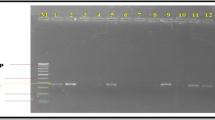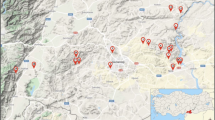Abstract
This study was performed to isolate non-rhizobial endophytic bacteria from the root nodules of Glycine max (soybean), Vigna radiata (mung bean) and Vigna unguiculata (cowpea). The bacteria were characterized for plant growth promoting properties such as indole acetic acid production, phosphate and zinc solubilisation, nitrogen fixation and hydrogen cyanide production. Phylogenetic identification was performed using the Neighbour-Joining method on16S rRNA gene sequences. The impact of salt tolerant isolates on some properties of wheat cv. Chamran was evaluated by a completely randomised factorial design. Nine isolates having some characteristics related to plant growth promotion were identified as Staphylococcus hominis 7E, Streptomyces sp. 11E, Bacillus sp. 13E, Acinetobacter sp. 19E, from mung bean, Bacillus endophyticus 1E from cowpea, Staphylococcus hominis 9E, Bacillus endophyticus 14E, Brevundimonas sp. 16E and Kocuria sp. 26E from soybean nodules. Isolates 7E and 19E caused maximum growth inhibition of Fusarium on PDA plate. All isolates were able to grow at salinity levels of mixtures containing up to 400 mM of NaCl, CaCl2 and MgCl2, but their growth was inhibited by increasing salinity level. Only the growth of isolate 14E increased at three levels of salinity compared with control. Some isolates, i.e. 7E, 14E, 19E and 26E had higher colony diameter at 45 °C after 48 h of incubation compared to the growth at 30 and 40 °C. Inoculation of soil with isolate 1E and isolate 26E caused to ameliorate salinity stress in wheat and increased the weight of 1000-grains as compared with non-inoculated treatments.

Similar content being viewed by others
References
Almeida DM, Oliveira MM, Saibo NJ (2017) Regulation of Na+ and K+ homeostasis in plants: towards improved salt stress tolerance in crop plants. Genet Mol Biol 40(1):326–345
Alori ET, Glick BR, Babalola OO (2017) Microbial phosphorus solubilization and its potential for use in sustainable agriculture. Front Microbiol 8:971
Ashraf M, Hasnain S, Berge O, Mahmood T (2004) Inoculating wheat seedlings with exopolysaccharide-producing bacteria restricts sodium uptake and stimulates plant growth under salt stress. Biol Fertil Soil 40(3):157–162
Bai Y, Zhou X, Smith DL (2003) Enhanced soybean plant growth resulting from coinoculation of Bacillus strains with Bradyrhizobium japonicum. Crop Sci 43(5):1774–1781
Bakker AW, Schippers B (1987) Microbial cyanide production in the rhizosphere in relation to potato yield reduction and Pseudomonas spp. mediated plant growth-stimulation. Soil Biol Biochem 19(4):451–457
Bashan Y, Puente ME, de-Bashan LE, Hernandez JP (2008) Environmental uses of plant growth-promoting bacteria. Plant-Microbe Int 661(2):69–93
Bent E, Tuzun S, Chanway CP, Enebak S (2001) Alterations in plant growth and in root hormone levels of lodgepole pines inoculated with rhizobacteria. Can J Microbiol 47(9):793–800
Berg G, Krechel A, Ditz M, Sikora RA, Ulrich A, Hallmann J (2005) Endophytic and ectophytic potato-associated bacterial communities differ in structure and antagonistic function against plant pathogenic fungi. FEMS Microbiol Ecol 51(2):215–229
Bric JM, Bostock RM, Silverstone SE (1991) Rapid in situ assay for indoleacetic acid production by bacteria immobilized on a nitrocellulose membrane. Appl Environ Microbiol 57(2):535–538
De Meyer SE, De Beuf K, Vekeman B, Willems A (2015) A large diversity of non-rhizobial endophytes found in legume root nodules in Flanders (Belgium). Soil Biol Biochem 83:1–11
de Oliveira-Longatti SM, Marra LM, Soares BL, Bomfeti CA, Da Silva K, Ferreira PAA, de Souza Moreira FM (2014) Bacteria isolated from soils of the western Amazon and from rehabilitated bauxite-mining areas have potential as plant growth promoters. World J Microbiol Biotechnol 30(4):1239–1250
Dhole A, Shelat H, Vyas R, Jhala Y, Bhange M (2016) Endophytic occupation of legume root nodules by nifH-positive non-rhizobial bacteria, and their efficacy in the groundnut (Arachis hypogaea). Ann Microbiol 66(4):1397–1407
Dinesh R, Srinivasan V, Hamza S, Sarathambal C, Gowda SA, Ganeshamurthy AN, Gupta SB, Nair VA, Subila KP, Lijina A, Divya VC (2018) Isolation and characterization of potential Zn solubilizing bacteria from soil and its effects on soil Zn release rates, soil available Zn and plant Zn content. Geoderma 321:173–186
Döbereiner J, Day JM, Dart PJ (1972) Nitrogenase activity in the rhizosphere of sugarcane and other tropical grasses. Plant Soil 37(1):191–196
Felsenstein J (1985) Confidence limits on phylogenies: an approach using the bootstrap. Evolution 39:783–791
Goldstein AH (1994) Involvement of the quinoprotein glucose dehydrogenase in the solubilization of exogenous phosphates by gram-negative bacteria. Phosphate in microorganisms: cellular and molecular biology. ASM Press, Washington, pp 197–203
Goteti PK, Emmanuel LDA, Desai S, Shaik MHA (2013) Prospective zinc solubilising bacteria for enhanced nutrient uptake and growth promotion in maize (Zea mays L.). Int J Microbiol 2013:1–7
Hansda A, Kumar V (2017) Cu-resistant Kocuria sp. CRB15: a potential PGPR isolated from the dry tailing of Rakha copper mine. 3 Biotech 7(2):132
Jeon JS, Lee SS, Kim HY, Ahn TS, Song HG (2003) Plant growth promotion in soil by some inoculated microorganisms. J Microbiol 41(4):271–276
Keisham M, Mukherjee S, Bhatla SC (2018) Mechanisms of sodium transport in plants—progresses and challenges. Int J Mol Sci 19(3):647
Khan MA, Ullah I, Waqas M, Hamayun M, Khan AL, Asaf S, Kang SM, Kim KM, Jan R, Lee IJ (2019) Halo-tolerant rhizospheric Arthrobacter woluwensis AK1 mitigates salt stress and induces physio-hormonal changes and expression of GmST1 and GmLAX3 in soybean. Symbiosis 77(1):9–21
Kim MJ, Radhakrishnan R, Kang SM, You YH, Jeong EJ, Kim JG, Lee IJ (2017) Plant growth promoting effect of Bacillus amyloliquefaciens H-2-5 on crop plants and influence on physiological changes in soybean under soil salinity. Physiol Mol Biol Plant 23(3):571–580
Kimura M (1980) A simple method for estimating evolutionary rate of base substitutions through comparative studies of nucleotide sequences. J Mol Evol 16:111–120
Kumar S, Stecher G, Li M, Knyaz C, Tamura K (2018) MEGA X: Molecular Evolutionary Genetics Analysis across computing platforms. Mol Biol Evol 35:1547–1549
Kumar V, Gera R (2014) Isolation of a multi-trait plant growth promoting Brevundimonas sp. and its effect on the growth of Bt-cotton. 3 Biotech 4(1):97–101
Leite J, Fischer D, Rouws LF, Fernandes-Júnior PI, Hofmann A, Kublik S, Schloter M, Xavier GR, Radl V (2017) Cowpea nodules harbor non-rhizobial bacterial communities that are shaped by soil type rather than plant genotype. Front Plant Sci 7(2064):1–11
Lin T, Zhao L, Yang Y, Guan Q, Gong M (2013) Potential of endophytic bacteria isolated from Sophora alopecuroides nodule in biological control against Verticillium wilt disease. Aust J Crop Sci 7(1):139–146
Marag PS, Suman A (2018) Growth stage and tissue specific colonization of endophytic bacteria having plant growth promoting traits in hybrid and composite maize (Zea mays L.). Microbiol Res 214:101–113
Nadeem SM, Zahir ZA, Naveed M, Asghar HN, Arshad M (2010) Rhizobacteria capable of producing ACC-deaminase may mitigate salt stress in wheat. Soil Sci Soc Am J 74(2):533–542
Negrão S, Schmöckel SM, Tester M (2017) Evaluating physiological responses of plants to salinity stress. Ann Bot 119(1):1–11
Pikovskaya RI (1948) Mobilization of phosphorus in soil in connection with the vital activity of some microbial species. Microbioligiya 17:362–370
Pirhadi M, Enayatizamir N, Motamedi H, Sorkheh K (2016) Screening of salt tolerant sugarcane endophytic bacteria with potassium and zinc for their solubilizing and antifungal activity. BBRC 9(3):530–538
Premono ME, Moawad AM, Vlek PLG (1996) Effect of phosphate-solubilizing Pseudomonas putida on the growth of maize and its survival in the rhizosphere. Indones J Crop Sci 11(1):13–23
Queipo-Ortuño MI, Colmenero JDD, Macias M, Bravo MJ, Morata P (2008) Preparation of bacterial DNA template by boiling and effect of immunoglobulin G as an inhibitor in real-time PCR for serum samples from patients with brucellosis. Clin Vaccine Immunol 15(2):293–296
Rajendran G, Sing F, Desai AJ, Archana G (2008) Enhanced growth and nodulation of pigeon pea by co-inoculation of Bacillus strains with Rhizobium spp. Bioresour Technol 99(11):4544–4550
Rey T, Dumas B (2017) Plenty is no plague: Streptomyces symbiosis with crops. Trends Plant Sci 22(1):30–37
Saravanan VS, Subramoniam SR, Raj SA (2004) Assessing in vitro solubilization potential of different zinc solubilizing bacterial (ZSB) isolates. Braz J Microbiol 35(1–2):121–125
Sarode Prashant D, Rane Makarand R, Chaudhari Bhushan L, Chincholkar Sudhir B (2009) Siderophoregenic Acinetobacter calcoaceticus isolated from wheat rhizosphere with strong PGPR activity. Malays J Microbiol 5(1):6–12
Schrey SD, Tarkka MT (2008) Friends and foes: Streptomycetes as modulators of plant disease and symbiosis. Antonie Van Leeuwenhoek 94(1):11–19
Schulz B, Wanke U, Draeger S (1993) Endophytes from herbaceous and shrubs: effectiveness of surface sterilization method. Mycol Res 97:1447–1450
Shabala S, Cuin TA (2008) Potassium transport and plant salt tolerance. Physiol Plant 133(4):651–669
Saitou N, Nei M (1987) The neighbor-joining method: a new method for reconstructing phylogenetic trees. Mol Biol Evol 4:406–425
Tariq M, Hameed S, Yasmeen T, Ali A (2012) Non-rhizobial bacteria for improved nodulation and grain yield of mung bean [Vigna radiata (L.) Wilczek]. Afr J Biotechnol 11(84):15012–15019
Tariq M, Hameed S, Yasmeen T, Zahid M, Zafar M (2014) Molecular characterization and identification of plant growth promoting endophytic bacteria isolated from the root nodules of pea (Pisum sativum L.). World J Microbiol Biotechnol 30(2):719–725
Velázquez E, Martínez-Hidalgo P, Carro L, Alonso P, Peix A, Trujillo ME, Martínez-Molina E (2013) Nodular endophytes: an untapped diversity. Beneficial Plant-Microb Inter. https://doi.org/10.1201/b15251-11
Vincent JM (1970) A manual for the practical study of the root-nodule bacteria. International Biological Programme. Blackwell Scientific, Oxford
Wang Q, Yang S, Liu J, Terecskei K, Ábrahám E, Gombár A, Domonkos Á, Szűcs A, Körmöczi P, Wang T, Fodor L (2017) Host-secreted antimicrobial peptide enforces symbiotic selectivity in Medicago truncatula. Proc Natl Acad Sci 114(26):6854–6859
Yaish MW, Antony I, Glick BR (2015) Isolation and characterization of endophytic plant growth-promoting bacteria from date palm tree (Phoenix dactylifera L.) and their potential role in salinity tolerance. Antonie Van Leeuwenhoek 107(6):1519–1532
Zainudin MHM, Hassan MA, Tokura M, Shirai Y (2013) Indigenous cellulolytic and hemicellulolytic bacteria enhanced rapid co-composting of lignocellulose oil palm empty fruit bunch with palm oil mill effluent anaerobic sludge. Biores Technol 147:632–635
Zakhia F, Jeder H, Willems A, Gillis M, Dreyfus B, De Lajudie P (2006) Diverse bacteria associated with root nodules of spontaneous legumes in Tunisia and first report for nifH-like gene within the genera Microbacterium and Starkeya. Microb Ecol 51(3):375–393
Zhao L, Xu Y, Lai X (2018) Antagonistic endophytic bacteria associated with nodules of soybean (Glycine max L.) and plant growth-promoting properties. Braz J Microbiol 49(2):269–278
Acknowledgement
Authors would like to thank the Research council Shahid Chamran University of Ahvaz for the support of this study (GN. SCU.AS98.248).
Author information
Authors and Affiliations
Corresponding author
Ethics declarations
Conflict of interests
The authors have declared no conflict of interests.
Additional information
Communicated by Erko stackebrandt.
Publisher's Note
Springer Nature remains neutral with regard to jurisdictional claims in published maps and institutional affiliations.
Electronic supplementary material
Below is the link to the electronic supplementary material.
Rights and permissions
About this article
Cite this article
Bakhtiyarifar, M., Enayatizamir, N. & Mehdi Khanlou, K. Biochemical and molecular investigation of non-rhizobial endophytic bacteria as potential biofertilisers. Arch Microbiol 203, 513–521 (2021). https://doi.org/10.1007/s00203-020-02038-z
Received:
Revised:
Accepted:
Published:
Issue Date:
DOI: https://doi.org/10.1007/s00203-020-02038-z




